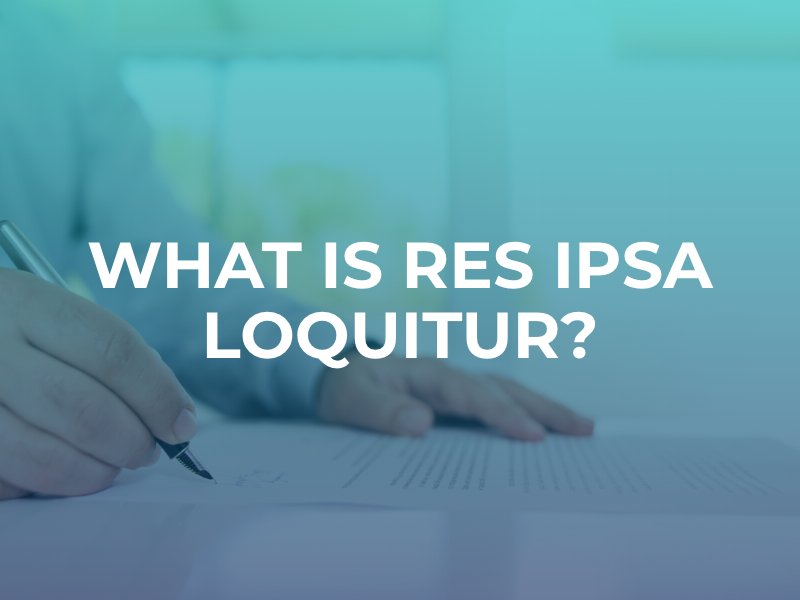Res Ipsa Loquitur and Evidence Law – Legal Definition
Res ipsa loquitur is a word that means ‘the thing that speaks for itself. ‘ The concept operates that evidential ruling allows a plaintiff to establish a claim of negligence on the part of the defendant as a form of circumstantial evidence (Findlaw’s team). Even though plaintiffs have to prove that the defendant acted with negligence in many cases, within res ipsa loquitur, the plaintiff will froth the circumstantial evidence, and it is upon the defendant to prove that they did not act in negligent. Without a doubt, accidents happen all the time, and therefore in case of an accident, it doesn’t mean that it is the defendant’s fault that the accident occurs. But negligence has to be proved in all cases (Res ipsa loquitur). Within a personal injury lawsuit, the plaintiff must show evidence that the defendant’s actions due to negligence caused the injury to the plaintiff. Circumstantial evidence can still be used to establish negligence. Negligence, in this case, is inferred from the totality of the circumstances.
Within a res ipsa loquitur, there are three requirements that the plaintiff must meet before a ruling can be made that the defendant’s actions due to negligence caused the harm in question. The presence of negligence must be determined first. Some accidents can never occur unless someone acts negligently (Goodspeed, 616). Things never happen out of character unless someone somewhere did not take care of the duties they were supposed to attend to well. The second consideration is whether the defendant carries the sole responsibility for the injury. Sometimes this requirement will gather information on whether the defendant had exclusive control over the entity that caused the accident. For instance, if it is a surgeon conducting an operation and leaves a sponge inside a patient, then the surgeon’s negligence has brought about the injury due to negligence because they are the one who was in control during the operation. The third element is that the defendant owes the plaintiff a duty of care. If the type of injury does not fall within the scope of the defendant owes the duty of care, then the damage will not be a liability.
Within the first scenario, Yolanda will prevail against the restaurant. In this case, the server has a nostril, and it is missing, and it happens to be at the in the food of Yolanda ends up injuring her. Taking the scenario through proof of negligence, the duty to care must first be established. The server has a duty to Yolanda to ensure that the food she eats is safe for consumption. Therefore, when she brings the food to the table, it must not, in any case, be of danger. Clearly, there was a breach of duty as the personal belongings of the server were within the food. There was also causation. The breach of duty caused the victim’s injuries. Finally, there was damage. Yolanda was indeed injured as her tooth was broken. This lawsuit would prevail upon the server.
A piece of ceramic the same color as the plate would be lawsuit negligence towards the restaurant. Proving negligence shows that the restaurant has a duty to ensure that everything they use is safe for the customers (Hatton,536). Therefore, the restaurant had a duty to Yolanda. The duty of care on the utilities used was broken. The causation was that the breach of duty caused an injury to Yolanda. There was also damage. Yolanda’s tooth was broken; therefore, there was damage. This lawsuit would prevail better if applied to the restaurant management because they are the ones responsible for the safety of the customers through the items that they decide to use on the customers.
A tiny rodent skull is a clear public health issue. It would be questionable how the hotel passed a health inspection, and therefore the lawsuit would work best when directed to the restaurant management. There is a clear duty that the defendant has on the victim’s care, ensuring more significant public health for the customers. There was also a clear breach of the duty as there was a rodent’s skull on the food. There was also causation as the tooth of Yolanda was broken. Finally, the damages were the broken tooth. Thus, the lawsuit should be directed to the management of the restaurant.
The tip of a human finger is a clear violation of law and a public health concern. The suit can be directed towards the restaurant management because one of the chefs or cooks on leave might have dropped it. Either way, the food came from the kitchen. It is clear that the restaurant is supposed to maintain cleanliness and hygiene for the customers. There is also a clear breach from the restaurant because there is evidence of the finger human finger. The causation is that the finger caused an injury to Yolanda. There is also evidence of damage which is Yolanda’s broken tooth. Therefore, there is a possibility that the lawsuit can prevail if the attorneys can prove where the finger was from. That is if they can find the person who owns the finger. The restaurant can decide to deny the case if they do not find the owner of the fingertip.







